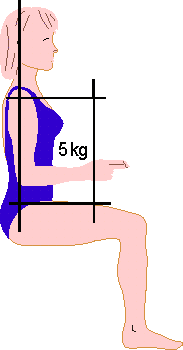| Computing |
|
Numerical guidelines for lifting and lowering while standing |
Numerical outlines for lifting and lowering whilst seated |
 |
 |
|
The basic guideline figures
for lifting and lowering are for relatively infrequent operations
- up to approximately 30 operations per hour - where the pace of
work is not forced, adequate pauses for rest or recovery are possible
and the load is not supported for any length of time. They should
be reduced if the operation is repeated more frequently. As a rough
guide the figures should be reduced by 30% where the operation is
repeated once or twice per minute, by 50% where the operation is
repeated around five to eight times per minute and by 80% where
the operation is repeated more than about 12 times per minute.
|
|
Plan the lift, assessing and reducing the risk of injury. Observe the task, identifying ways of making it easier and less risky, less physically demanding. Determine how the load will be handled and where it will be placed. By assessing the situation first one can decide if a handling aid, a transporter, or another person is needed to move the object, animal or person.
Problems to look for when planning a task:
Does the task involve:
- holding loads away from the body?
- twisting?
- stooping?
- large vertical movement?
- long carrying distances? ( > 10 meters)
- strenuous pushing or pulling?
- risk of unpredictable load movement?
- frequent or prolonged physical effort? e.g.. more than once every 5 minutes or periods greater than 1 hour
- insufficient rest periods?
- work rate imposed by a process?
|
Is the load:
Working environment. Are there:
Does the job:
Clothing and Equipment
How do you know if something is too heavy to lift? Test the weight before you try to lift the object by crouching down and trying to turn it or tip it on its edge. Do not use your feet to slide or test the weight. If the object will not slide easily on carpet or is too heavy to tip, it is too heavy to lift. |
 |